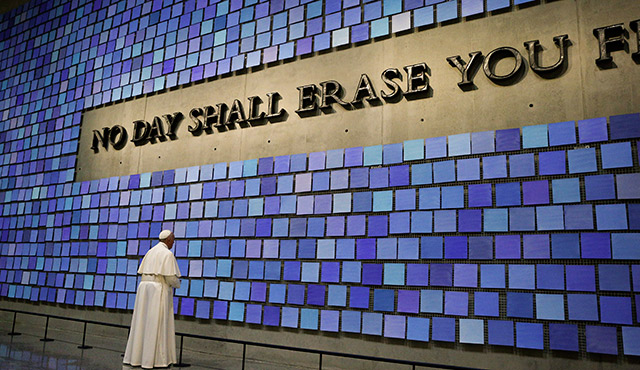“Here, grief is palpable.”
Pope Francis made this comment when he visited, last fall, the site of the Sept. 11 terrorist attacks.
Anyone who has been to the reflecting pools and the 9-11 National Memorial at Ground Zero can attest to the pope’s words.
As the nation and the world commemorate the 15th anniversary of the attack by the Islamic terrorist group Al-Qaeda that killed 2,996 people and injured more than 6,000, Catholics also reflect on the tragedy and what it means, and continues to mean, in the context of their faith.
“9/11 will always be seared in my memory,” says the Rev. Msgr. Arthur A. Holquin, episcopal vicar for divine worship for the diocese and pastor emeritus at Mission San Juan Basilica.
“I was the rector of Holy Family Cathedral at the time of the attack that occurred shortly before school opened,” Msgr. Holquin says. “All the children gathered for a special Mass that morning as we prayed for all the victims. The darkness of that day was made a bit lighter by our prayerful solidarity at the altar with our sisters and brothers who suffered so much as a result of this senseless tragedy.”
Of course, no parish felt the crushing agony of 9/11 — and continues to feel it most acutely today — than St. Peter’s Church, located at 22 Barclay Street, only a block away from where the World Trade Center towers once majestically stood.
The terrorist attacks “without a doubt made us stronger and more connected,” reads a detailed message on the church’s website (spcolr.org) titled “Our Remembrance of Sept. 11, 2001.”
Fr. Kevin Madigan was pastor of St. Peter’s Church at the time. He recalled after the second plane hit the tower seeing a wheel of an airplane fly over his head. The landing gear of one of the planes pierced the roof of the church.
A lector at St. Peter’s and a parishioner at the mission of St. Joseph’s Chapel, which is part of the church, were killed on 9/11.
In addition to serving as a relief supply station, the church provided pastoral care to rescue workers and those allowed to enter the area. It was open 24/7 for the workers until the end of October 2001, when martial law was lifted and workers returned to offices in downtown Manhattan.
Father Mychal Judge, chaplain of the New York Fire Department, was the first certified fatality of the terrorist attacks. For a while, his body was placed at the altar of St. Peter’s.
Father Madigan played a role in preserving what became a relic of hope in the days after 9/11: two huge steel beams of the wreckage that resembled a cross. From 2006 through 2011, the 6,000 lb. cross stood outside St. Peter’s. It currently is housed inside the 9/11 museum.
Ten years after 9/11, a new custom cross was installed to stand in the same place outside St. Peter’s to represent the resurrection of the neighborhood.
After the attacks, St. Joseph’s Chapel became a FEMA command station. It also became a temporary sanctuary where construction workers, police offers and firefighters could come to eat, email their families, talk with spiritual counselors and “rest from the physically, emotionally and spiritually exhausting work at Ground Zero,” as the church’s website put it.
A Catholic memorial, meant to impart the broad message that life is stronger than death, was included in the refurbished St. Joseph’s Chapel. The memorial’s message—life is stronger than death—echoes the broad response to 9/11 among Catholic leaders.
James R. Nicholson, the former U.S. ambassador to the Holy See, told the Catholic News Agency about meeting, for the first time, with Pope John Paul II, a few days after 9/11, to receive his diplomatic credentials.
“Ambassador Nicholson,” the pope told him, according to CNA, “this was an attack, not just on the United States, but on all of humanity.”
He added: “We must stop these people who kill in the name of God.”
The response of the U.S. Conference of Catholic Bishops to the Sept. 11 attack, issued in November 2001, urges, among other things, Catholics to reach out to those in need and to avoid succumbing to hate, revenge and violence, particularly against Arab-Americans and Muslims.
It’s a message that continues to resonate loudly today.
“These things can really create a sense of anger and even hatred and bitterness and a thirst for vengeance, and none of those things hold a place in the Catholic Church,” says Father Christopher Smith, rector of the Christ Cathedral.
“That’s why, in many ways, forgiveness is truly divine,” Father Smith adds. “It takes something beyond ourselves to be able to get to that point. And forgiveness is never instant. It’s a process.”
Father Smith says even if we are never able to forgive the people who carried out the Sept. 11 terrorist tasks — or those who have committed countless atrocities since then — just being open to the possibility of forgiveness means we are on the right track.
“With that attitude,” he says, “we automatically are going to be something other than being bent on seeking revenge.”


